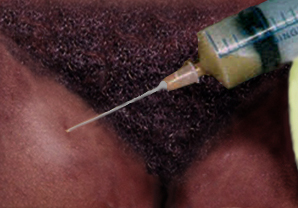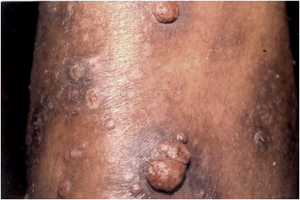Bartonella
CASE 1
• A 47 year old female was referred for an enlarged, tender, right femoral mass unresponsive to a 10-day course of cephalexin (a first-generation cephalosporin). She denied fever or other constitutional symptoms. Two week prior to the onset of adenopathy, she had a small, pustule on the right, upper inner thigh that healed spontaneously.
• The patient had a household cat to control mice living in and around her house. She recalls being scratched on the leg when she was carrying a dish of milk to the cat.
• On physical examination, she was afebrile. However, she had a solitary fluctuant mass below the right inguinal groove.
• Needle aspiration yielded yellow pus, negative on Gram stain and culture.

• A serologic test to detect antibodies against Bartonella henselae was positive at 1:1250. A diagnosis of cat scratch disease was made.
Questions:
1. Would you expect to find B. henselae on a silver stain of the lymph node? How abundant would you expect the bacteria to be? What types of cells would you expect to find infiltrating the lymph node?
2. Is Bartonella an intracellular pathogen? Is it an obligate intracellular pathogen?
3. How does the infection in the patient differ from the infection in the cat? Which cells in the cat are thought to represent the reservoir of infection?
4. How would you characgterize the vigor of the patient's immune response to this infection?
5. What will be the outcome of the infection if the patient receives no antibiotic therapy?
CASE 2
• A 34 year old woman with HIV/AIDS comes to the hospital with increasing fevers and chills over the past 3 weeks. She has developed nodular skin lesions over her extremities and trunk during this period. Some of the skin lesions are fleshy and appear to be "stuck-on." If manipulated, they bleed profusely.
• The patient has been a known AIDS patient for 3 years. She has had other opportunistic infections in the past, and has a total CD4 count of ~50/mm3 at the present time. She acquired a new kitten in her household one month ago.
• On physical examination, she is febrile to 39 degrees. The patient has no palpable lymphadenopathy. A close-up of some of the skin lesions is shown below.

• Based on the appearance of the skin lesions, she is diagnosed with bacillary angiomatosis and treated with erythromycin. Her fevers gradually resolve, and the skin lesions recede slowly. Blood was collected and cultured using the lysis-centrifugation method. The centrifuged pellet was inoculated on chocolate agar and incubated at 35 degrees in a high CO2 atmosphere. Two weeks later, colonies of Bartonella began to appear on the plate.
Questions:
1. This disease is also caused by Bartonella henselae. Why is the presentation so different from case 1?
2. If you were to biopsy one of the skin lesions, would you expect to find B. henselae bacteria using a silver stain? Would they be abundant in the tissues? What changes would you expect to find in the blood vessels in the lesions, and why?
3. How would you characterize the immune response against B. henselae in this patient?
4. What would be the expected outcome of infection if the patient did not receive erythromycin therapy?